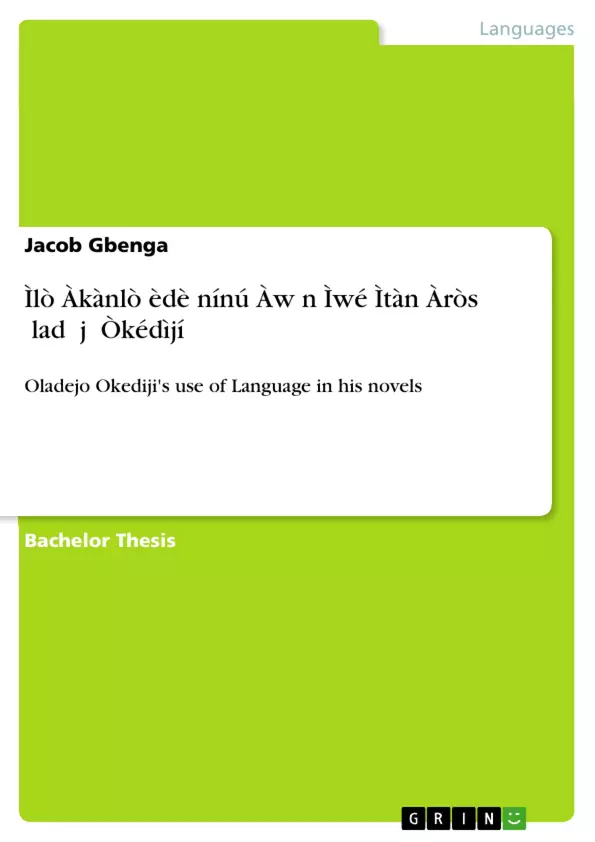Èdè jẹ́ ọ̀nà kan tí à ń gbà bá ara wa sọ̀rọ̀. Ọpẹ́yẹmí (2015:21) ṣàlàyé pé èdè ni ariwo tí ó ti ẹnu àwa ènìyàn jáde tí ó ní ìtumọ̀, tí ó ní iṣẹ́ láti jẹ́ fún ẹni tí ó gbọ́ ọ, tí ó ní ìlànà kan pàtó tí àwọn elédè ń tẹ̀lé, tí ó sì jẹ́ ìtẹ́wọ́gbà fún gbogbo àwọn olùsọ èdè náà. Èdè ni òpómúléró fún iṣẹ́ lítíréṣọ̀, láì sí èdè, kò lè sí àtiwáyé iṣẹ́ lítíréṣọ̀. Oríṣiríṣi ọ̀nà ni àwọn elédè ń gbà mú èdè wọn rẹwà yálà ní sísọ lẹ́nu tàbí nínú kíkọ sílẹ̀. Gbogbo àwọn èdè tó gbajú-gbajà ní àgbáyé bí Èdè Gẹ̀ẹ́sì, Faransé, Potogí, Lárúbáwá, Swàhílì àti bẹ́ẹ̀ bẹ́ẹ̀ lọ ló ní àwọn ọnà amédè-rẹwà fún afọ̀. Èyí kò sì yọ èdè Yorùbá sílẹ̀. Àwọn ìpèdè bẹ́ẹ̀ ni àwọn onímọ̀ pè ní àwọn “Ọnà-èdè", wọ́n sì máa ń mú kí afọ̀ Yorùbá kún fún ìmọ̀, ìtumọ̀ àti òye. Irúfẹ́ àwọn ìpèdè bẹ́ẹ̀ yàtọ̀ sí èdè ṣákálá tàbí àsọ̀jẹ ọ̀rọ̀ lásán. Àwọn ìpèdè yìí dúró gẹ́gẹ́ bí òpó fún afọ̀. Àwọn òpó wọ̀nyí ni àwọn Gẹ̀ẹ́sì pè ní “Figures of Speech”. Èyí fihàn pé gbogbo èdè ló ní tirẹ̀. Orúkọ tí èdè kọ̀ọ̀kan ń pe tirẹ̀ ló yàtọ̀. Ọnà-èdè ni àwọn hóró ọ̀rọ̀ tàbí àwọn ìpèdè tí aṣafọ̀ múlò láti mú adùn wọ afọ̀ rẹ̀, oríṣiríṣi sì ni àwọn ọnà-èdè tí a ní nínú èdè Yorùbá, lára wọn ni òwe, àkanlò-èdè, àwítúnwí, àsọrégèé, ìfọ̀rọ̀dárà, ìfìrósínròjẹ, Ìbádọ́gba gbólóhùn, àfiwé àti bẹ́ẹ̀ bẹ́ẹ̀ lọ.
Inhaltsverzeichnis (Table of Contents)
- ORÍ KÌÍNÍ
- Èrèdí Ìwádìí
- Èròngbà Ìwádìí
- Ìwúlò Işé Ìwádií
- Ọgbọn Ìwádìí
- Ibi Tí Ìwádìí Yóò Gbòòrò Dé
- Ètò Ìwádìí
- Ìtàn Ìgbésí ayé Óládejọ Òkédìjí
- ORÍ KEJÌ
- ORÍ KẸTA
- ORÍ KẸRIN
- ORÍ KARÙN-ÚN
Zielsetzung und Themenschwerpunkte (Objectives and Key Themes)
The main objective of this research is to examine the use of figures of speech, particularly proverbs, in the Yoruba language, and to explore their significance in the crime fiction of the renowned Yoruba novelist, Ọládėjo Òkédìjí. This study aims to shed light on Òkédìjí's stylistic choices and how he uses figures of speech to convey meaning and create literary impact.
- The use of figures of speech in Yoruba literature
- The significance of proverbs in crime fiction
- The stylistic choices of Ọládėjo Òkédìjí
- The relationship between language and culture
- The literary and social context of Yoruba crime fiction
Zusammenfassung der Kapitel (Chapter Summaries)
Chapter one introduces the research topic, outlines the research rationale, and presents the research questions, objectives, methodology, and theoretical framework. It also provides a brief biography of Ọládėjo Òkédìjí.
Chapter two examines the theoretical background and relevant scholarly discussions on the use of figures of speech in Yoruba literature, specifically proverbs, and the relationship between language, culture, and society. This chapter also reviews previous studies on the works of Ọládėjo Òkédìjí.
Chapter three provides an in-depth analysis of the two crime novels, “Àjà ló lerù” and “Agbalagbà Akàn”, by Ọládėjo Òkédìjí, focusing on their thematic content, plot, characters, and narrative techniques. This chapter also explores the use of proverbs in the novels and their implications for the interpretation of the text.
Chapter four continues the analysis by examining the use of specific figures of speech, specifically proverbs, in the two novels. This chapter analyzes the function, meaning, and context of these figures of speech in relation to the broader themes and narrative structure of the novels.
Schlüsselwörter (Keywords)
The main keywords and focus topics of this research are: Ọládėjo Òkédìjí, Yoruba crime fiction, figures of speech, proverbs, Yoruba language, literary analysis, cultural context, narrative techniques, and societal impact.
- Quote paper
- Jacob Gbenga (Author), 2017, Ìlò Àkànlò èdè nínú Àwọn Ìwé Ìtàn Àròsọ Ọladẹ̀jọ Òkédìjí, Munich, GRIN Verlag, https://www.grin.com/document/434477



